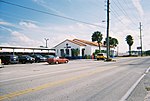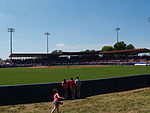Winter Haven Heights Historic Residential District
Historic districts on the National Register of Historic Places in FloridaNRHP infobox with nocatNational Register of Historic Places in Polk County, FloridaPolk County, Florida Registered Historic Place stubsUse mdy dates from August 2023 ... and 1 more
Winter Haven, Florida

The Winter Haven Heights Historic Residential District (also known as Winter Haven Heights Historic District) is a U.S. historic district in Winter Haven, Florida. It is roughly bounded by Lake Martha, 2nd Street Northeast, 5th Street Northeast, and Avenue A Northeast, encompasses approximately 450 acres (1.8 km2), and contains 147 historic buildings. On June 15, 2000, it was added to the U.S. National Register of Historic Places.
Excerpt from the Wikipedia article Winter Haven Heights Historic Residential District (License: CC BY-SA 3.0, Authors, Images).Winter Haven Heights Historic Residential District
4th Street Northeast,
Geographical coordinates (GPS) Address Nearby Places Show on map
Geographical coordinates (GPS)
| Latitude | Longitude |
|---|---|
| N 28.024166666667 ° | E -81.722777777778 ° |
Address
4th Street Northeast 100
33881
Florida, United States
Open on Google Maps








